Instructions for growing melon in Siberia in open ground for beginner gardeners
Melon fruits are surprisingly tasty and healthy. In addition to vitamins, they contain a lot of fiber, pectin, potassium, magnesium, phosphorus, silicon and organic acids. From the sweet, aromatic pulp they make jams and marmalade, preserves and preserves, and make candied fruits. Fresh melon provides the greatest health benefits.
More and more gardeners throughout Russia are planting this crop on their plots. Growing melon in Siberia in open ground is not an easy task, since it is a southern plant. But a smart choice varieties, site preparation and proper care of plantings ensure a good harvest of sweet fruits even in the harsh Siberian climate.
Growing melon in the Siberian climate
Melons are cultivated in Siberia both in greenhouses and in open ground. An important condition for plant development is an average daily air temperature of at least +15°C.
The fruits ripen approximately 3 months after the first shoots. The critical period is from the moment of sowing to the first 3 leaves. If these days the temperature during the day does not fall below +25°C, and at night - below +10°C, the pumpkins grow quickly and ripen.
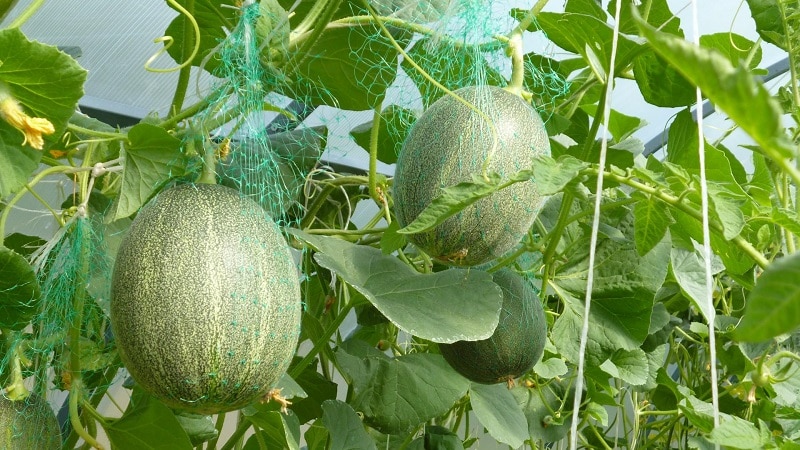
Weather
The heat-loving melon is traditionally cultivated in the south. In Siberia, this crop began to be grown recently, after the creation of new early ripening varieties and hybrids.
In the south of the region, the crop grows well - there are enough sunny days in summer for the fruits to ripen. A significant disadvantage of such a climate is its unpredictability. Dry and hot days give way to cold and rainy ones.In the first half of June there are often frosts and even snow. It is important to take all these features into account before cultivating melon in Siberia.
Suitable varieties
The key to successfully growing a crop in unusual climatic conditions is the correct choice of variety. In Siberia, melon is cultivated in open ground only through seedlings, giving preference to zoned and cold-resistant varieties.
Important! When choosing a variety, they are guided by the average number of warm summer days (without frost). This period is counted from the date of the last spring frost and ends with the date of the first autumn frost. Fruit ripening time indicated on the seed package should be slightly shorter than the range.
The harsh climate is variable, and in such conditions it is difficult to accurately determine the frost-free period. Therefore, when growing melons, they are guided by the average temperature indicators of recent years.
Good results are achieved by cultivating early ripening varieties and hybrids. The most popular: Sybarite's Dream, Altai, Muscat white, Titovka, Caramel, Cappuccino, Lyubushka, Early 133.
Preparing seeds and soil
To grow strong and healthy melon bushes, the seeds and soil are treated in advance.
Seed preparation
The hybrid seeds are not prepared for planting - the producer has already done everything himself. When independently collecting planting material or purchasing varietal species, processing is carried out.
First, the seeds are checked for germination by placing them in a glass of water. The floating seeds are empty and are discarded.
The next stage is disinfection. They destroy pathogens and pests by soaking the grains in a pink solution of potassium permanganate for 15 minutes.To increase germination, specimens are immersed in a solution of potassium humate or aloe juice for 30 minutes. After completing the wet treatments, the seeds are dried.
Attention! Melon seeds are planted 2-3 years after collection. This measure increases the number of female flowers, and therefore the yield.
Germination of planting material accelerates the emergence of seedlings. To do this, it is kept for several days in a warm place in a damp cloth or sawdust.
Soil preparation
A sunny area protected from cold winds is allocated for the melon.
Favorable predecessors are tomatoes, peppers, eggplants, beans, cabbage, peas, potatoes. These crops are affected by pests and diseases other than melon.
Important! It is not advisable to plant melons after related crops - watermelons, cucumbers, pumpkins, eggplants. They have common pests and diseases, and such plants take the same nutrients from the soil.
The place for the melon bed is prepared in advance. Choose loose, breathable soil. The site is dug up and weeds and their roots are removed along the way. If the soil is heavy, add sand (5 kg per 1 m2).
The bed is fertilized with humus at the rate of 1 bucket per 1 m2. Additionally, mineral fertilizers (superphosphate, potassium salt, nitrogen) are applied according to the instructions on the package.
Growing seedlings
Summer in Siberia is short and often cool, so it is preferable to grow melon from seedlings here. Seeds are planted in late April - early May. Melon, like all melons, does not tolerate transplants well: if the roots are damaged, the plant withers and dies. Therefore, seedlings are planted in peat pots or special cassettes. The diameter of the container must be at least 10 cm.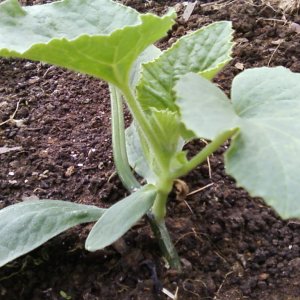
Soil for seedlings can be purchased at the store or prepared independently.To do this, mix peat and sand (8:1), add 1 tbsp. wood ash and sawdust.
The prepared containers are filled 2/3 with soil mixture. The seeds are buried 4-5 cm. The container is covered with film or glass. After the sprouts appear, the cover is removed.
Containers with seedlings are transferred to a warm, illuminated place. The required air temperature is +20°C...+25°C during the day and at least +15°C at night. If there is not enough sunlight, the plants are illuminated with a phytolamp.
Important! Proper melon seedlings are healthy sprouts with a short, strong stem and 3-4 true leaves.
The seedlings are watered with warm water as the top layer of soil dries. A week before transplanting, a fertilizing mixture of 1 liter of water, 1.5 g of ammonium sulfate, 1 g of superphosphate and 1 g of potassium salt is applied to a permanent place.
In warm weather, seedlings are taken outside for hardening, gradually increasing the duration of the plants' stay in the fresh air. On the last day before landing, they are left outside for the whole day.
Ready seedlings are transplanted to a permanent place 30–35 days after sowing. Longer development of plants at home leads to their overgrowth and weakening.
Planting and care
Before planting seedlings, check the soil temperature; it should not be lower than +15°C. Usually in Siberia the ground warms up sufficiently in early June.
Plants are planted according to a 70x70 cm pattern in pre-prepared and moistened holes. Peat pots are tightly covered with soil and watered. The root collar is left flush with the soil surface. For the first 2-3 days, seedlings are protected from the sun with covering material.
The row spacing is loosened as the crust forms. After the appearance of side lashes, the bushes are hilled.
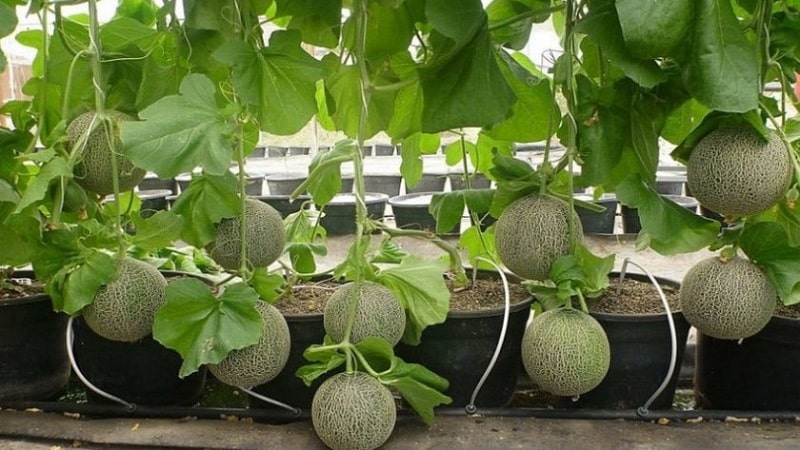
Watering
Moisten the bushes with warm, settled water.For 1 plant use 5–7 liters of liquid.
Important! Moisture on the root collar and foliage provokes the development of fungal diseases. Therefore, water is poured under the root or at a distance of 3–5 cm from the stem.
The watering regime for melon beds depends on the stage of development of the bushes. After picking, seedlings in dry weather are watered every day in small quantities. When the plants take root, the frequency of irrigation is increased to 1-2 times a week. When the fruits ripen, watering is reduced to 2 times a month.
Feeding
For the first time, melon seedlings are fertilized 2 weeks after transplanting to a permanent place. To do this, use a solution of mullein (1:10) or ammonium nitrate (20 g per 10 liters of water).
Subsequent feedings are applied at intervals of 2 weeks. Use a solution of 50 g of superphosphate, 30 g of potassium salt and 30 g of ammonium sulfate per 10 liters of water.
Ready-made complex fertilizers are used in accordance with the manufacturer's recommendations. They are introduced only after abundant watering (1–1.5 liters per bush).
To ensure that the fruits receive more nutrients, the bushes are shaped. This speeds up the ripening of pumpkins, increasing their sweetness and quality.
Protection from diseases and pests
Melon crops are susceptible to fungal infections. The development of diseases is promoted by low temperatures, high air and soil humidity, and insufficient heat and sunlight. This provokes the appearance of putrefactive processes on the leaves and fruits.
When caring for plantings, follow some rules:
- when watering, avoid getting water on the leaves and vines;
- moisturize the bushes moderately, avoiding excess liquid;
- when picking, maintain a sufficient distance between the bushes;
- plantings are periodically thinned out, excess vines and leaves are removed;
- follow the rules of crop rotation.
In addition to diseases, melon is subject to attack by insect pests. The main preventive measure against them is to treat the seeds in disinfecting solutions (manganese, copper sulfate, Fundazole and other similar products).
Harvesting
Depending on the variety, the fruits begin to ripen towards the end of July. To determine the ripeness of a melon, just lightly press on the peel - on a ripe fruit it will press slightly. Melons are removed from the garden as they ripen.
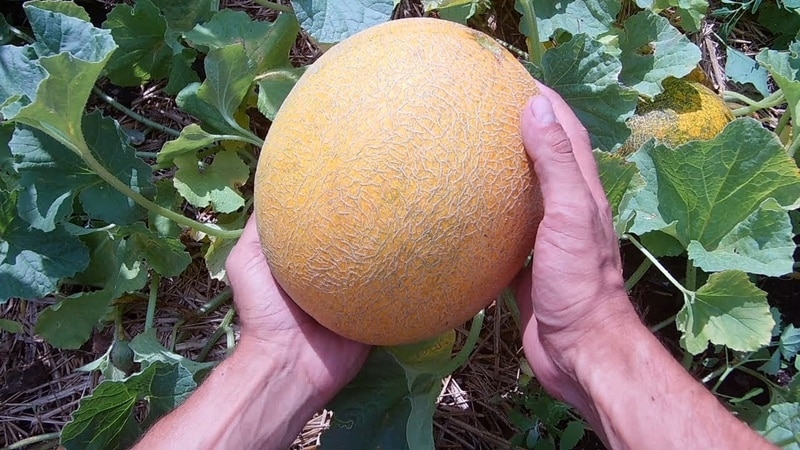 The last harvest is carried out before the onset of cold weather. Fruits that have not yet ripened are placed on shelves with the stalk facing up or placed in wooden boxes, covered with straw. In such conditions, the crop will ripen in 2 weeks.
The last harvest is carried out before the onset of cold weather. Fruits that have not yet ripened are placed on shelves with the stalk facing up or placed in wooden boxes, covered with straw. In such conditions, the crop will ripen in 2 weeks.
When determining the timing of fruit collection, they are guided by weather conditions. If it’s dry and warm outside, you don’t have to rush into cleaning. During prolonged rains and cold weather, melons are removed before technical ripeness.
Growing melon in Siberia in warm beds
This method of cultivation has long been used by Siberians to grow cucumbers in open ground. It is also suitable for melon.
Preparation of a warm bed begins in the fall. The process consists of successive stages:
- First, use a rope to mark the area. The top layer of soil is removed.
- Construct a box from boards or plywood. The walls should rise above the ground surface by about 20 cm.
- The bottom of the pit is lined with chopped branches, grass, tree bark, and plant debris.
- Half of the excavated soil is poured on top.
- In the spring, horse manure mixed with straw is laid out (about 10 cm).
- The top of the bed is covered with the remaining soil.
After construction is completed, the bed is spilled with hot water and covered with a dark film, the ends of which are pressed to the ground.
Inside the structure, manure and straw rot and generate heat. In a week, the warm bed will be ready for transplanting seedlings or sowing.
Attention! Manure on a warm bed warms the soil for 2-3 weeks. Therefore, seedlings are planted in such a bed earlier than in a regular one.
If it is impossible to obtain horse manure, it is replaced with cow or poultry manure, but in this case the heating of the area will take longer, and the period of heat release will be shortened.
Advice from experienced gardeners
Advice from experienced farmers will help beginning gardeners reap a good harvest of melon fruits:
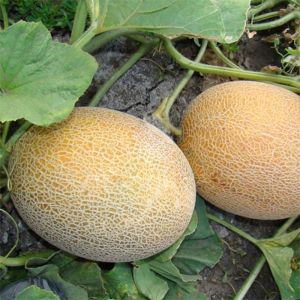
- grow melons in warm beds - this way the bushes will be stronger and the harvest will ripen earlier;
- pinch the bushes in a timely manner - this will speed up the ripening of the fruits;
- When carrying out pinching, do not spare the extra vines - in a short summer, all the formed melons will not have time to ripen, and the fruits will grow small and unsweetened;
- avoid dense plantings; bushes need a lot of space to grow and develop;
- During the ripening period, place boards or other dry material under the fruits to prevent spoilage and rotting of the crop.
Read also:
Is it possible to eat melon with cholecystitis and cholelithiasis?
Conclusion
Growing the heat-loving beauty of melon in the harsh Siberian climate is not an easy task. Choosing the right variety, building warm beds and proper care of the bushes will help you cope with it. Following the recommendations will allow you to reap a rich harvest of sweet and healthy fruits even in unfavorable weather conditions.